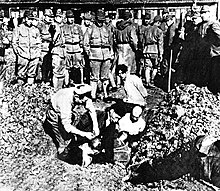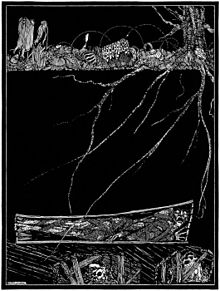Buried alive

Buried alive has been known as a form of sacrifice or execution since ancient times. Due to inadequate medical knowledge, accidental burials of pseudo-dead occurred until modern times . The fear of it is known as taphephobia .
Historical examples
In the Roman Empire , vestal virgins were buried alive in cases of unchastity ( crimen incesti ). During their tenure as priestesses, the Vestals guarded the fire of the city of Rome . Their chastity was a religious duty and symbolized the purity of the city from divine calamity. A staged funeral procession accompanied the Vestal Virgin after her sentencing to Porta Collina , where the execution was carried out. Food was added to the vestal virgin in her grave, presumably to absolve the community of the charge of direct killing. The lover was then scourged to death in the Comitium with a flagrum by the pontifex maximus . Pliny the Younger describes in detail the execution of the vestal virgin Cornelia as the "atonement" of the emperor Domitian, who was struggling with political difficulties .
In addition, in Rome in 228, 216 and 114/3 BC. A pair of Greeks and Gauls each was buried alive on the Forum Boarium to avert current military emergencies . Evidence for what is probably the latest ancient Roman human sacrifice can be found in particular in Christian apologetic historiography. The selection of these groups of people was possibly based on the traditional destruction of Troy , the legend of the city of origin of the Romans, by the Greeks and the destruction of Rome in 387 BC. By the Gauls. However, it is more likely that the choice of sacrifice goes back to the influence of the Etruscans, i.e. from a time when the great external enemies of Rome were Greeks and Celts (Gauls).
The burning of books and the burying of scholars alive were large-scale measures taken by the first emperor of China , Qin Shihuangdi (259 BC-210 BC).
Artistic design
In the opera Aida , the general Radames is walled up alive as a traitor. His supposedly saved lover Aida, however, has hidden in the burial chamber and dies with him voluntarily.
The fear of being buried alive enjoyed some popularity as a motif in 19th century literature (→ taphephobia in literature, film and art ). An example of the literary processing of the basic feeling is Edgar Allan Poe's black-humored short story The Premature Burial .
Some films are based on a perpetrator-victim relationship, such as in Lebendig Buried (1962) , Vanished Without A Trace (1988) and Kill Bill - Volume 2 (2004) , Buried - Lebend Buried (2010) , Dolan's Cadillac (2009). In the German-language television series Der Bergdoktor , one episode bears the title Buried Alive (2016), which is only meant metaphorically.
The artist group “ monochrom ” has been running a project called “ Buried Alive” since 2005 , in which they made it possible for people to be buried alive for 15 minutes.
The topic is also occasionally thematized in music, for example from Welle: Erdball Lebendig Buried , Venom Buried Alive , Front Line Assembly Buried Alive , Eisregen In der Grube and Dame Lebendig Buried .
literature
- Briggs L. Twyman: Metus Gallicus. The Celts and Roman Human Sacrifice. In: Ancient History Bulletin 11, 1997, ISSN 0835-3638 , pp. 1-11.
- Arthur M. Eckstein: Human sacrifice and fear of military disaster in republican Rome. In: American Journal of Ancient History 7, 1982, ISSN 0362-8914 , pp. 69-95.
- A. Fraschetti: La sepoltura delle Vestali e la città . In: Du châtiment dans la cité. Supplices corporels et peine de mort dans le monde antique . Table ronde organisée par l'Ecole Française de Rome 9–11 November 1982. Boccard u. a., Paris 1984, ISBN 2-7283-0084-4 ( Collection de l'Ecole Française de Rome 79), pp. 97-129.
- Jan Bondeson Ph.D .: Buried Alive: The Terrifying History of Our Most Primal Fear. WW Norton & Company, 2002, ISBN 978-0-393-32222-4 .
Web links
Individual evidence
- ↑ Pliny, Epistulae 4:11; on this comment by Sherwin-White
- ↑ Orosius 4, 13, 1-3; 5.15.2-22.
- ↑ http://artists.letssingit.com/welle-erdball-lyrics-lebendig-beschaben-trg847v
- ↑ The radio play-like intro is intended to reproduce the acoustic impression of someone buried in the coffin of his own burial.
- ↑ http://www.magistrix.de/lyrics/Eisregen/In-Der-Grube-2005-62323.html ( page no longer available , search in web archives ) Info: The link was automatically marked as defective. Please check the link according to the instructions and then remove this notice. Describes the trains of thought of a person buried in a mass grave during the plague in the Middle Ages
